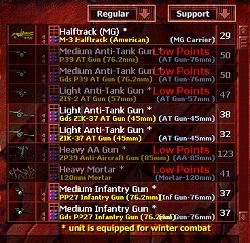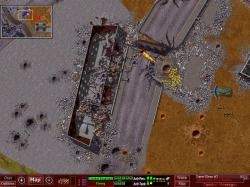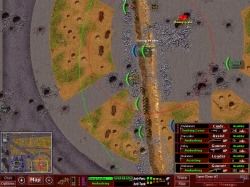|
Close Combat III: The Russian Front by Bubba "Masterfung" Wolford |
||||
Review System
In my January preview of Microsoft's Close Combat III (CC-III) I described, with typical pre-release enthusiasm, my impressions of the new features to the third installment of this classic game. Since that preview, I've obtained the retail version and have been playing it for some time with a more sober disposition. Were my expectations met? Will this re-fit maintain my long-lasting, mutually redemptive relationship I've been enjoying, or will I soon be cruising the game aisles at the all-night computer store looking for more exotic fare? In this first part of this review, I'll start with a bit of history, then move onto some of the highlights of preparing for battle and gameplay.  Fig. 1. Requisition of the troops and equipment. This screen is the most important part of what you will be doing in CC3 short of fighting the battle itself. Click for larger. For those not familiar with the Close Combat series, CC-III--like its predecessors--is essentially a real-time ground warfare simulation based on actual battles and operations of World War II (WWII). The first game in the series was based on Operation Overlord: codename for the invasion of Normandy. Designed with an entirely new approach to visuals and gameplay, an approach that had never been seen before in a real-time strategy (RTS) game, Close Combat turned out to be a smash hit. The second installment in the series was based on Operation Market Garden: codename of the largest (and unsuccessful) Allied airborne operation of WWII. This follow-up to the successful original introduced new player modeling; updated buildings for true line-of-sight; a new supply system for both sides (for reinforcements); plus gorgeous graphics and loads of new tanks, troops and weapons. A very tough act to follow, indeed. Close Combat III not only lives up to the great expectations of its predecessors, it once again sets the pace for innovative, exciting, and immersive RTS gameplay. Both Close Combat and Close Combat II were based on battles between the Germans and Americans. In CC-III the Americans are out and the Russians are in, fighting the Germans in what became the bloodiest Operation of WWII: Operation Barbarossa. Operation Barbarossa was the German invasion of Russia during the summer of 1941. The Germans believed that their surprise Blitzkrieg power-rush into Russia would be successfully concluded well prior to the onset of winter. This rather haughty assumption on the German's behalf caused them not to prepare or pack anything that might prove useful in a protracted winter operation! History proved this to be a grave miscalculation as the war dragged-on into December of 1941. The Germans, with their light clothing and improperly prepared vehicles and equipment, had to face not only the Russians themselves but also the brutal Russian winter. When it was all over, it was the Russian weather that beat the Germans as much as the Russian people. In CC-III, you can play as either the Germans or the Russians. Not surprisingly, Atomic Games has added loads of new troops, weapons, and armor to accommodate the game's addition of this new Russian / Eastern Front. Throw in increased resource allocation, improved AI, and maps with a range of resolutions topping out at 1600 X 1200, and even the most experienced veterans of the series will think they are playing an entirely new game.
D:>/setup.exe. HIT [PLAY]:
|
 Fig. 2. A Russian flamethrower is making the Germans feel a little toasty while a Russian Medium Battle Tank (MBT) stands ready to bring about his own form of destruction. Click for larger. As an aside, as your game moves forward in time, the AI models the actual developments in WWII weapon technology. This modeling of technological advancements will determine your choice of weapons at various stages in your battle. For example, at the outset of your campaign the Russians will not have the T-34 tank. As time moves forward in your game you'll find that the T-34, not available at the start, will have made its appearance---and not just one model, but several variants based on real-life enhancements!
The maps are outstanding. As the map comes up the game pauses so that each side may arrange its troops on the battlefield. Once ready for war, you click the "ready" button and time begins. One of the new features is that each battle can end in three different ways: by reaching a pre-defined time limit; by one side's capture of all the strategic points on the map; or by one side wiping out the other's entire force. You can also surrender your troops or withdraw them from the map: either action will cause the battle to end.
Improved AI
 Fig. 3. Here you can see the influence range of the Russian Commander in red and the secondary Command Vehicle in green. Notice how the vehicle, with the greater value and cost in requisition, also commands a larger influence ring than the Commander. Click for larger.
Commander Persona Consequently, if your Commander persona gets killed, the morale of your troops might collapse also. As in the first two games, each troop has his own emotional state. This state is constantly monitored to determine if a troop will continue with a heated fight, or run and hide from absolute fear, or even surrender outright. A troop's emotional state is not a byproduct of the Commander's persona alone, however. Rather, it is the result of a wider calculation based on the experience of the unit, the morale of the troop when brought to the front line, and the individual troop's health and leadership skills. |
|||
|
© 1997 - 2000 COMBATSIM.COM, INC. All Rights Reserved Last Updated March 15th, 1999 |
||||

